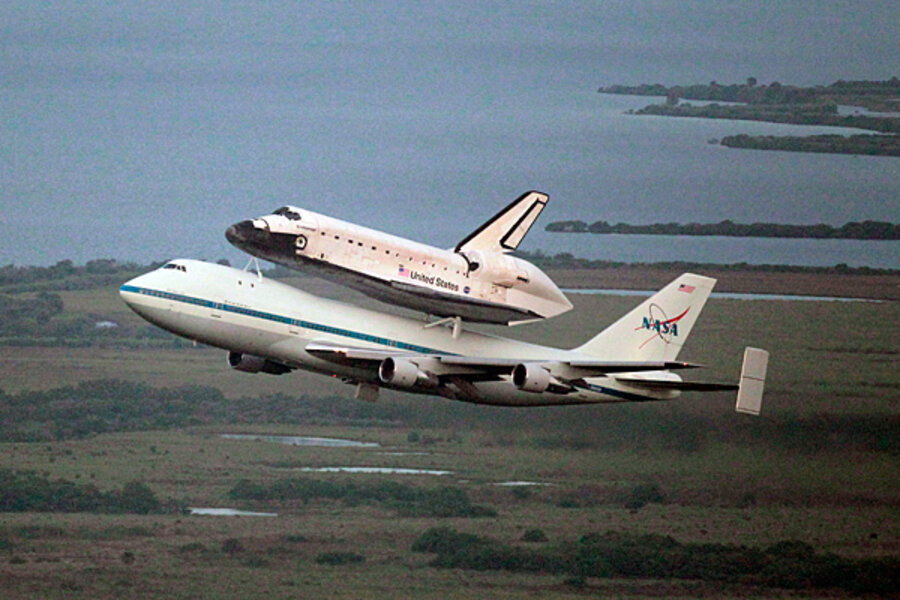Space shuttle Endeavour lifts off for last time, heading to California
Loading...
| Cape Canaveral, Fla.
Riding piggyback atop a Boeing 747 jumbo jet, the space shuttle Endeavour left its Florida home port for the last time on Wednesday and headed to California to begin a new mission as a museum exhibit.
After waiting two days for weather to clear, the specially modified carrier jet sped down the Kennedy Space Center runway shortly after dawn on Wednesday, the first leg of a planned three-day trek to the West Coast.
"There's sadness to see it go, but the space shuttle program had to end for us to move on to the next thing," said astronaut Greg Chamitoff.
NASA retired its three-ship fleet last year after completing the U.S. portion of the $100 billion International Space Station, a permanently staffed research complex that is owned by 15 nations and flies about 250 miles (400 km) above Earth.
The agency is developing a spaceship and rocket that can fly astronauts to the moon, asteroids and eventually Mars. The first flight with a crew, however, is not expected until 2021.
Russia now flies NASA astronauts to the space station, at a cost of more than $65 million a seat. NASA hopes to buy rides from commercial companies beginning in 2017.
Endeavour was built as a replacement for Challenger, the shuttle lost in a 1986 launch accident that killed seven astronauts. It went on to fly 25 missions, including 12 to build and outfit the space station.
It flew the first assembly mission, carrying up the Unity connecting node, which was attached to the Russian Zarya base module.
"It's hard to believe it was 14 years ago," said Kennedy Space Center director Bob Cabana, a former astronaut who commanded NASA's first station assembly flight in 1998.
Endeavour is the second of NASA's three surviving shuttles to be sent to a museum. Discovery, NASA's oldest surviving shuttle, is on display at the Smithsonian Institution's Steven F. Udvar-Hazy Center outside Washington.
Atlantis, which flew NASA's 135th and final shuttle mission in July 2011, will be towed down the road to the Kennedy Space Center Visitor Complex in November.
NASA lost a fourth shuttle, Columbia, in another fatal accident in 2003. That shuttle was not replaced.
Heading west
Endeavour's cross-country piggyback flight had been due to begin on Monday, but a cold front moving over Texas and into the Gulf of Mexico delayed its departure for two days.
As the sun rose over the oceanside spaceport in Florida, the shuttle carrier jet took off through partly cloudy, pink-tinged skies and headed south for a farewell pass over the neighboring beachside communities.
The duo circled back around to the Kennedy Space Center to give workers and guests gathered at the runway a final glimpse of a shuttle in the sky.
Additional low flyovers past NASA centers in Mississippi, Louisiana and Texas are planned, weather permitting, before the 747 lands at Ellington Field near the Johnson Space Center in Houston for the night.
Endeavour is due to depart Houston at dawn on Thursday, refuel at Biggs Army Airfield in El Paso, Texas, and head to NASA's Dryden Flight Research Center at Edwards Air Force Base in California, where it will land for the night.
On Friday Endeavour will be flown to northern California to pass by NASA's Ames Research Center at Moffett Field and landmarks in and around San Francisco, Sacramento and other cities.
The final leg of the journey will take Endeavour on a tour over Los Angeles before the 747 jet touches down at Los Angeles International Airport around 11 a.m. PDT (2 p.m. EDT/1800 GMT).
The shuttle will be taken off the carrier jet and moved to a United Airlines hangar to be prepared for transport next month to the California Science Center, about 12 miles (19 km) from the airport.
The trip to the museum, which will take place along Los Angeles neighborhood roads, requires some 400 trees to be cut down and the temporary removal of hundreds of utility poles, street lights and traffic signals to accommodate the 175,000-pound (79,379-kg) winged spaceship.
The California Science Center plans to plant 1,000 new trees to replace those taken down for Endeavour's road trip. The shuttle is due to go on display on Oct. 30.







